I received the Manker MK34 curtesy of Manker for the review.
Manker Provides these specs:
Features:
- Emitter: 12x Cree XP-G3 / 12x Nichia 219B (two version for your choice)
- Maximum output: 8000 lumens (Cree XP-G3 LED) / 6500 lumens (Nichia 219B LED)
- Maximum beam intensity: 20000cd (Cree XP-G3 LED),
- Maximum beam distance: 280M
- Waterproof: IPX-8 (2 meter under water)
- Impact resistance: 1.5meters
- Working voltage: 2.8v - 4.35v (Over discharge protection)
- Driver: Most efficiency constant current circuit
- Material: Aircraft-grade aluminum body
- Surface treatment: Premium Type III hard-anodized anti-abrasive finish
- Lens: Toughhened ultra-clear glass lens with anti-reflective coating
- Tail stand
Specifications:
Brightness Levels /Runtime (Cree XP-G3 LED):
Moonlight: 0.1-30lumens, 2month-5days; Low: 120lumens, 30hrs; Medium1: 500lumens, 7.5hrs; Medium2: 1000lumens, 3.5hrs; High 2500lumens 2h, Turbo 8000lumens; Strobe 8000lumens.
The light comes in this brown simple case
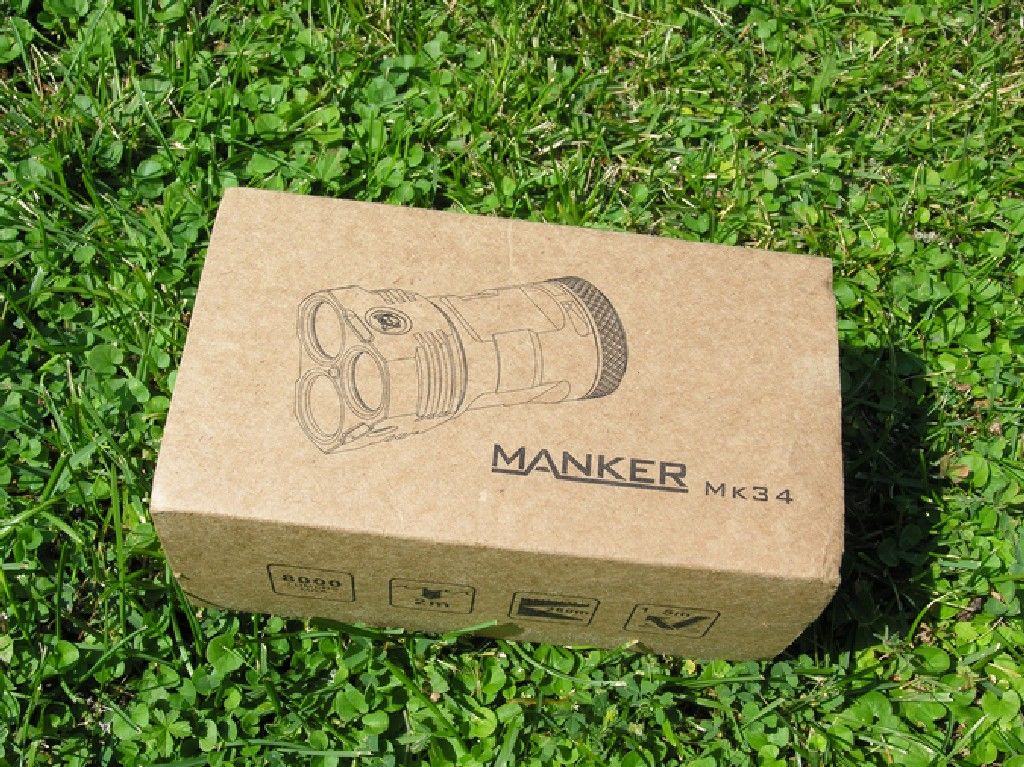
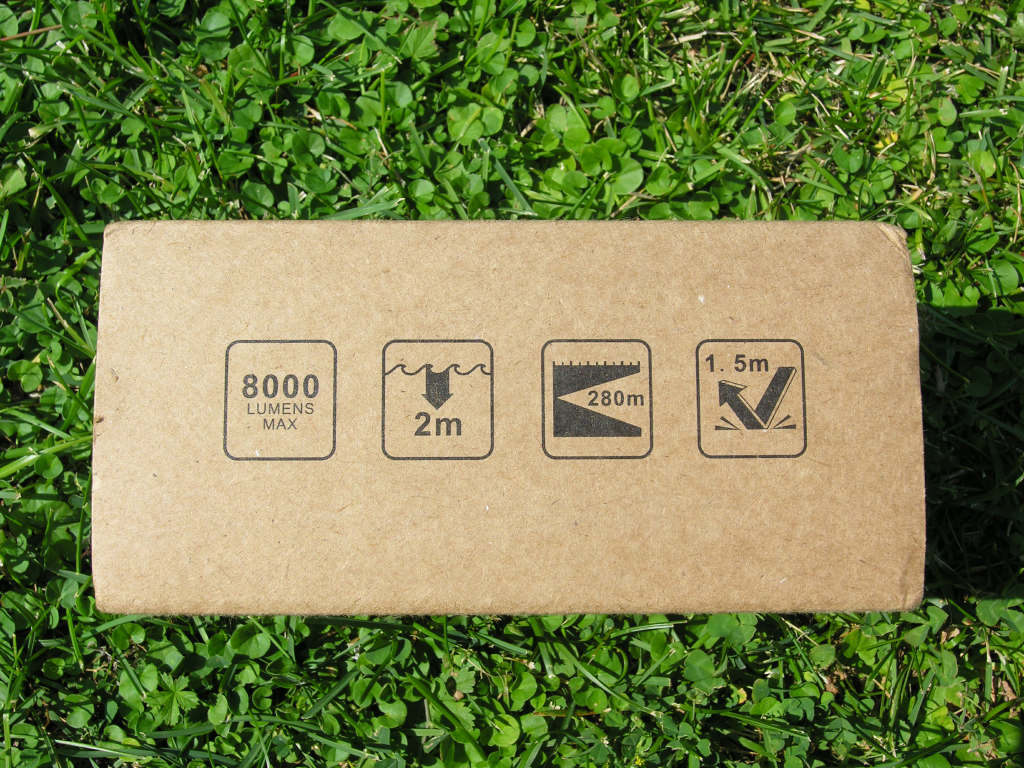
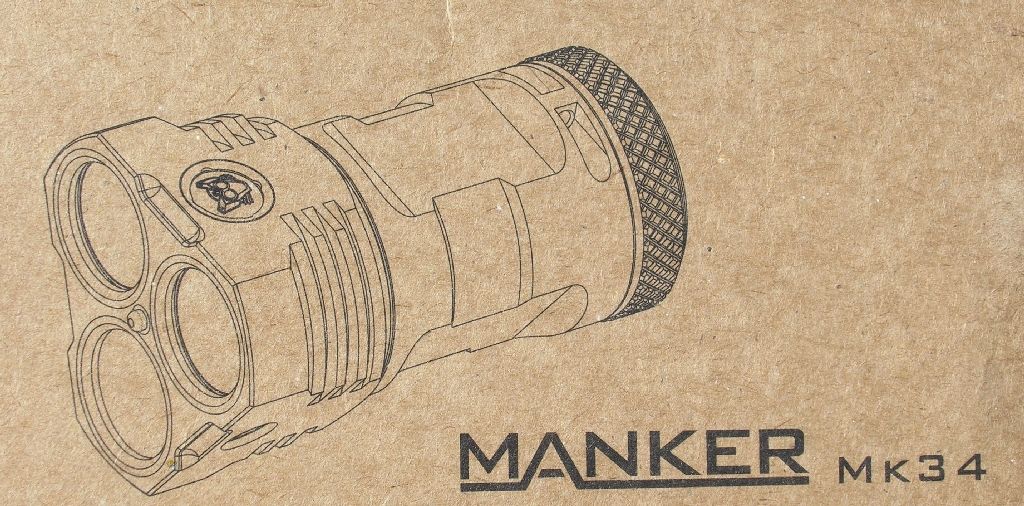
I got the XP-G3 CW version. A Nichia NW version is also available.
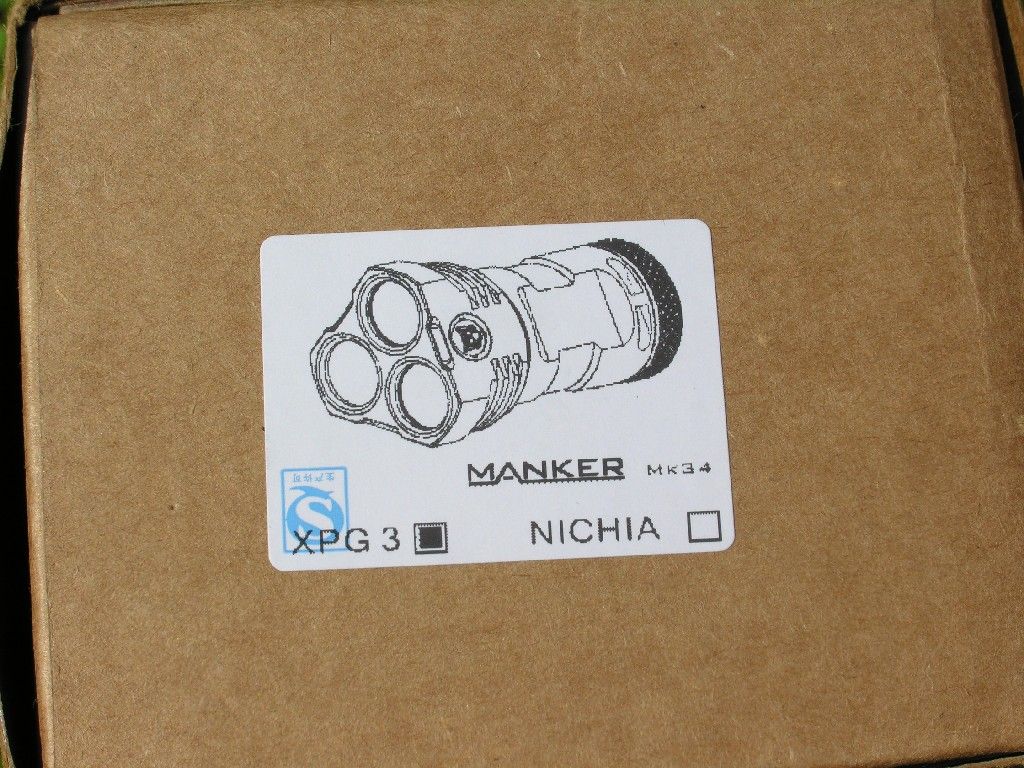
The light is well protected inside the box.
A very long instruction manual in English and Chinese. There are also spare orings and a lanyard.
And finally, the MK34.

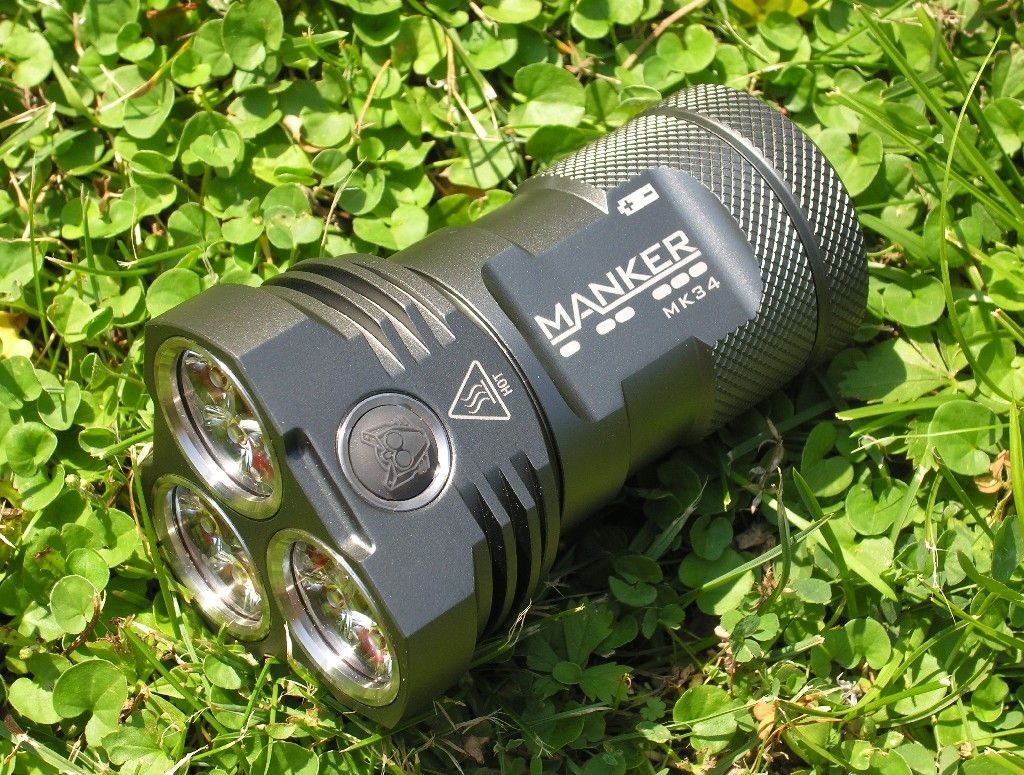
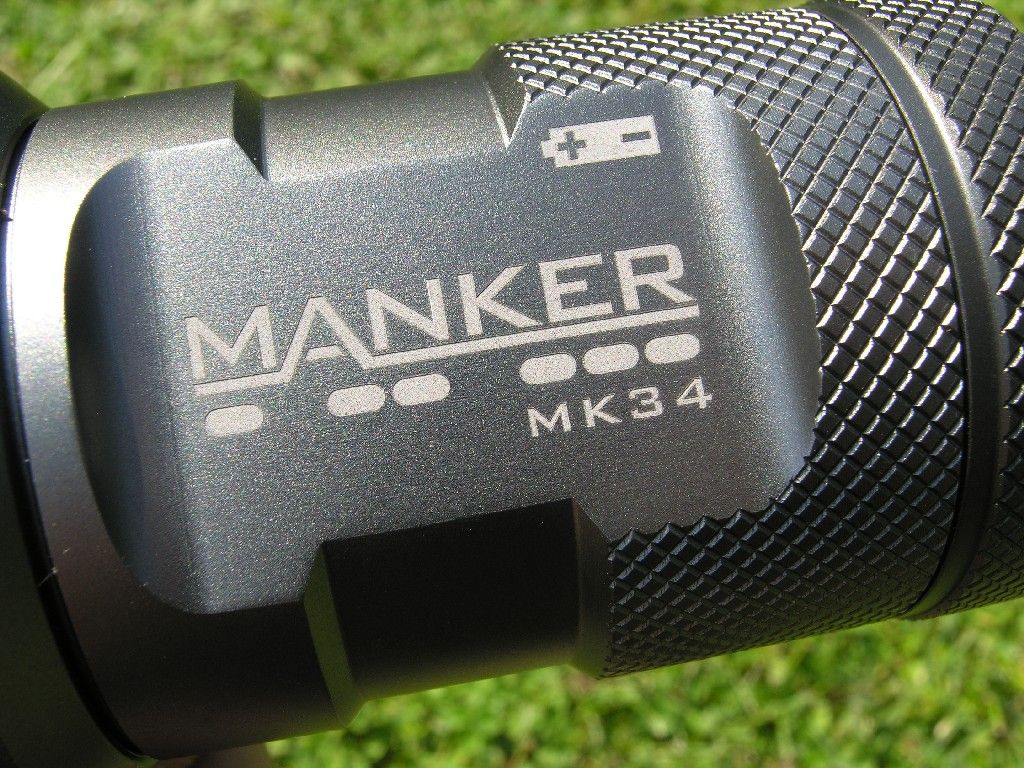
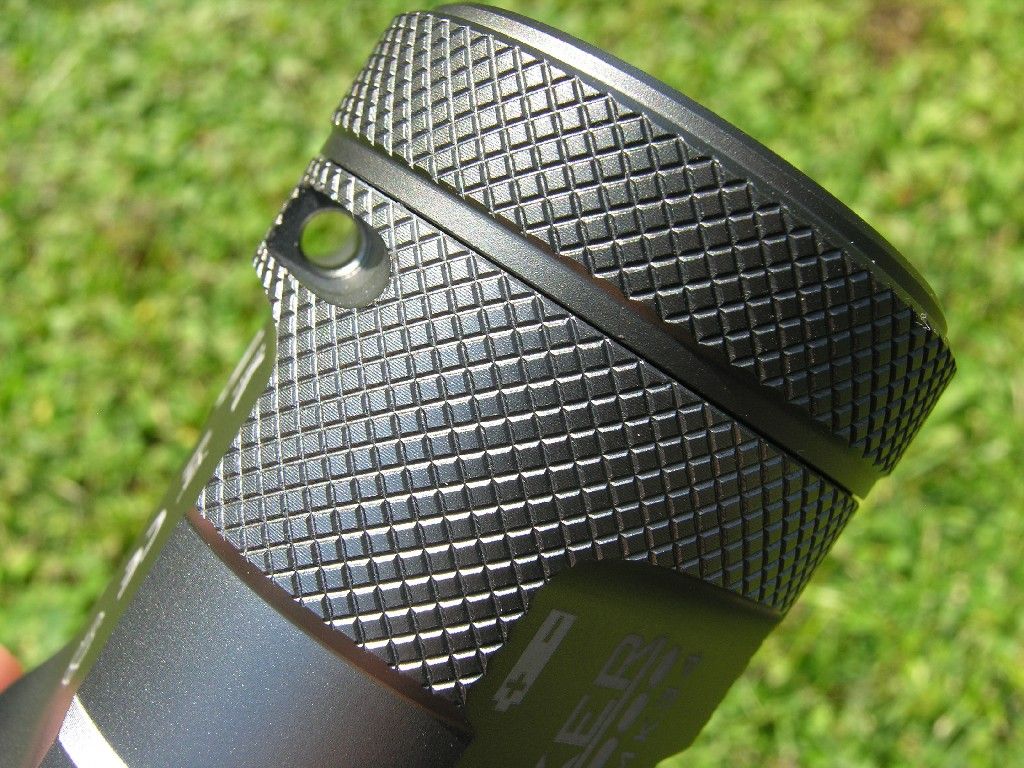
The anodization colour? I’ll describe is as a light grey.
The 3 optics with 4 leds each. Above each optic there is an AR treated glass. The metal bezels on my sample were not locked and I was able to unscrew them with my hands. The triangular shaped head also works as an anti rolling device.
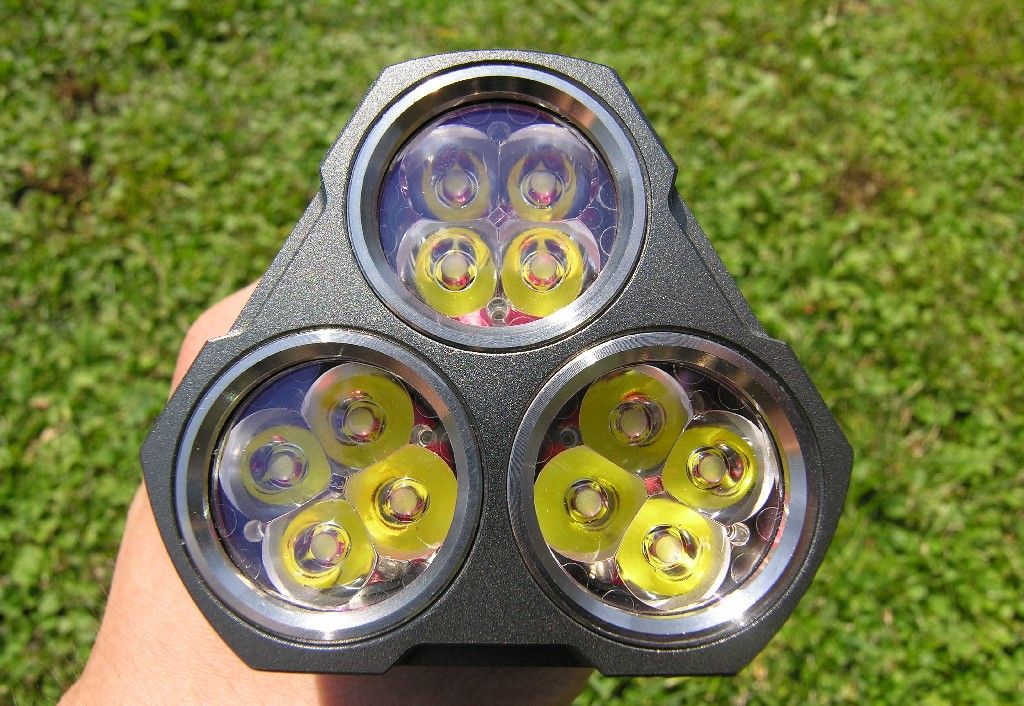
The tailcap is flat
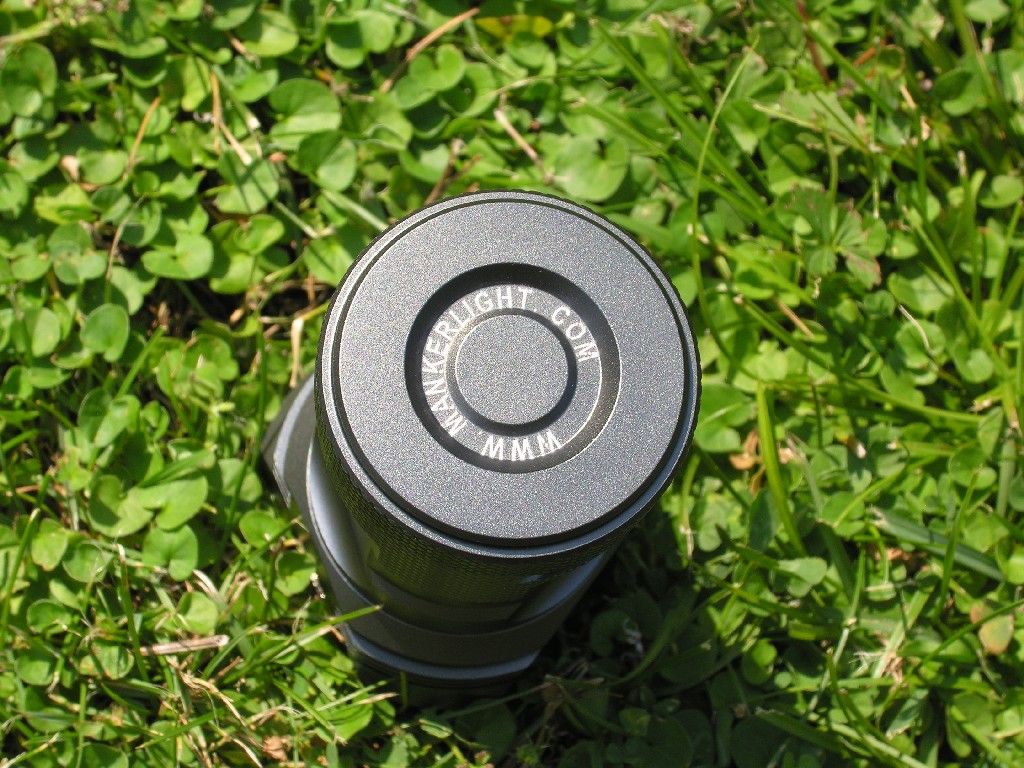
Double golden springs at the negative side of the batteries.
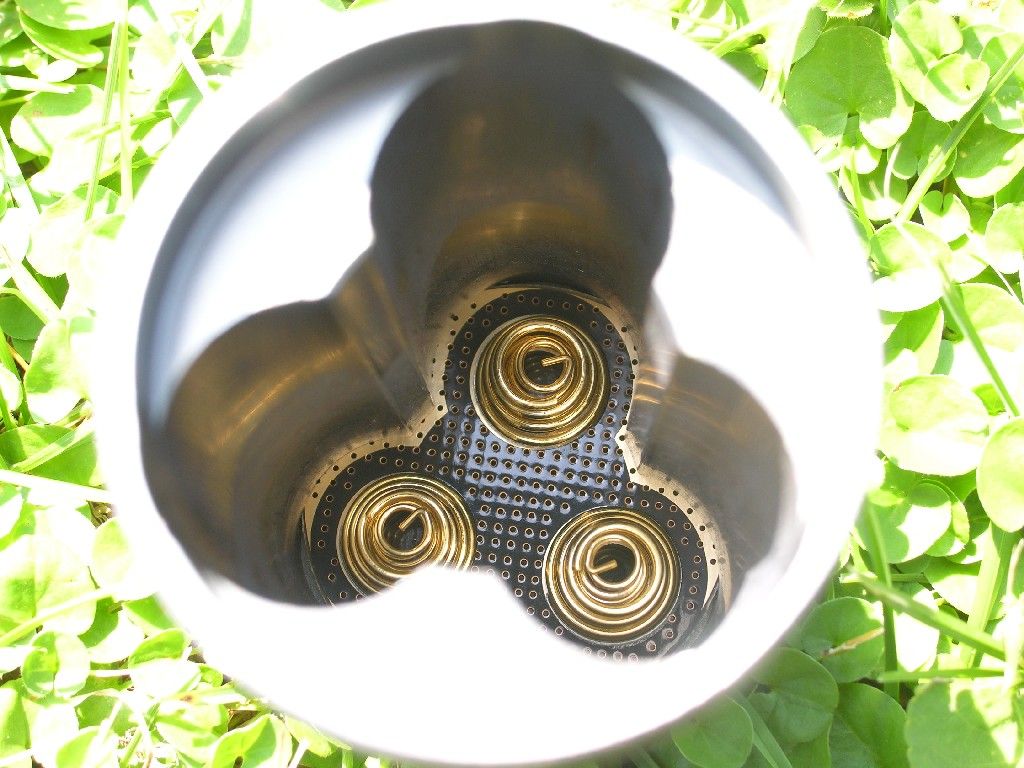
Anodized threads came greased. They allow physical lockout of the light
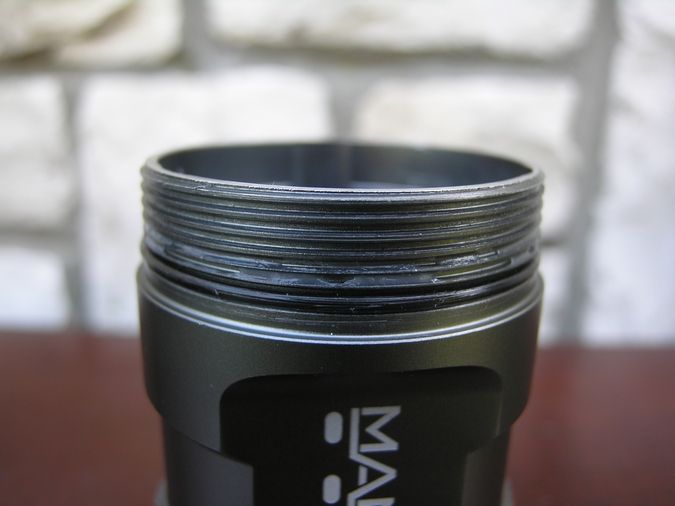
The body can be furtherly took apart. I tried to remove the tailcap but it feels locked. I believe there is some thread locker between the parts.
Under the switch there’s a blue led.
Big golden contact point at the head. Button top cells only.
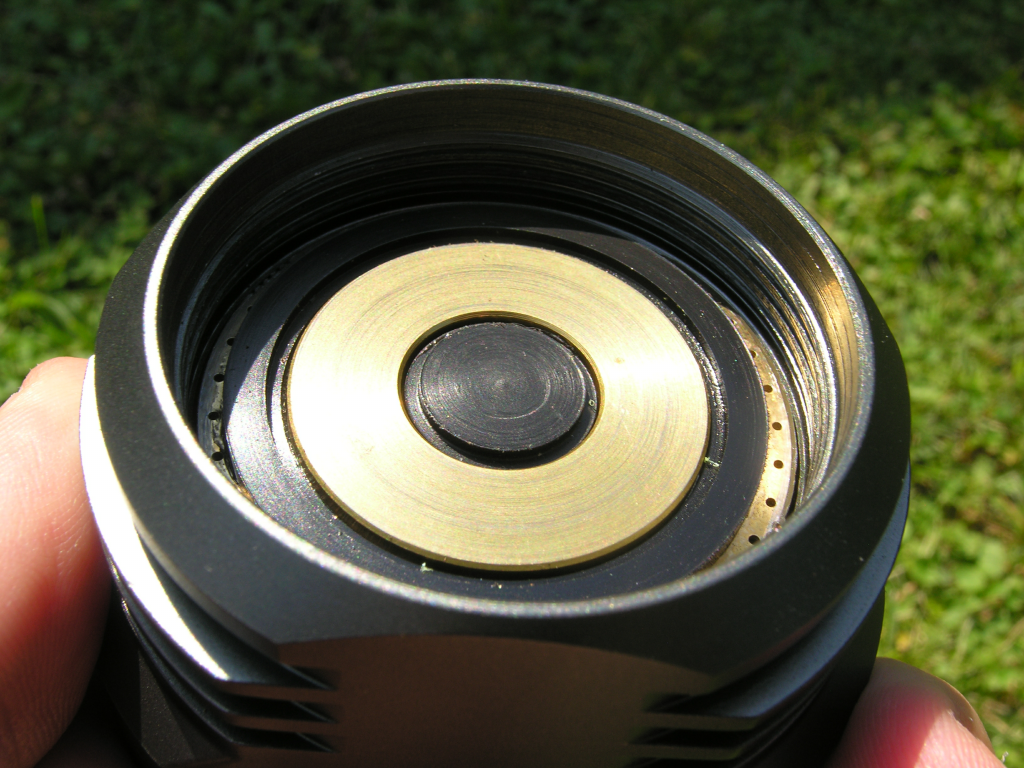
On one side, there is the tripod mount. For me this is the ideal posizion, since I can mount it on a tripod and use the light inclined (for example, when it is mounted on the tailcap, it has a shorter range of motion on the tripod).
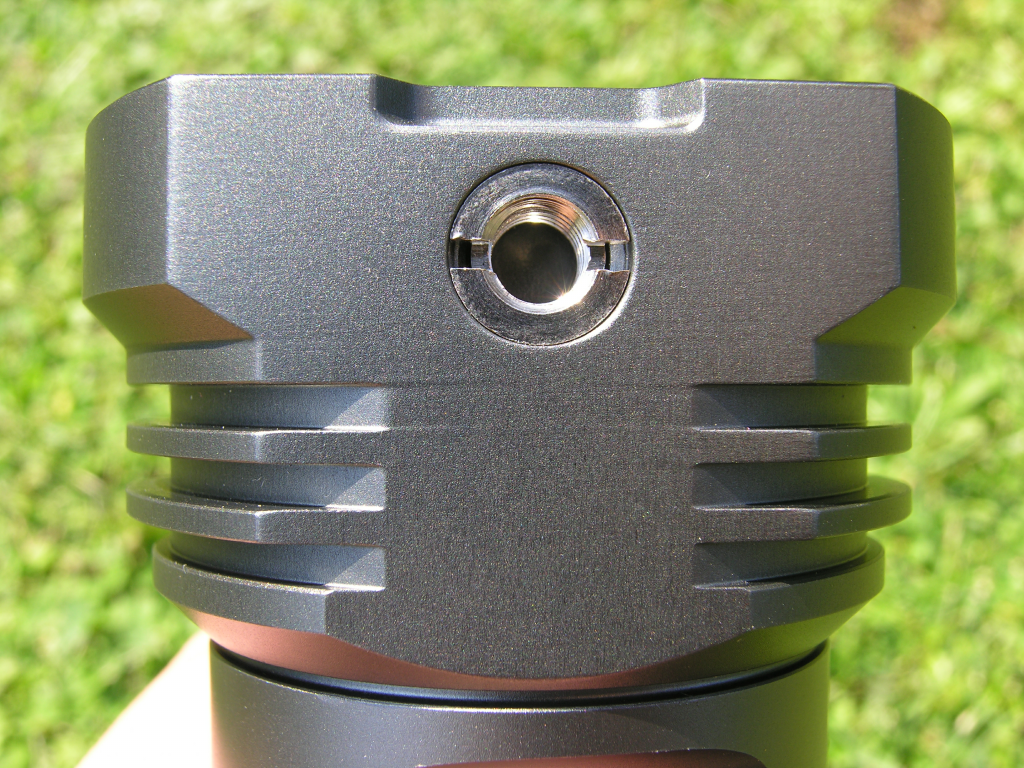
Before anyone asks, there are no handles available.
A handle mounted on the tripod screw will not make a lot of sense when holding the light because you will have to let the grip go from the handle to the light in order to reach the switch, or use 2 hands.
If you notice, until now there was not indications about size. No size comparison.
If you keep it in your hand by itself, you don’t realize how compact it is, trust me.
The light is 98 mm long, the head has a max diameter of 55 mm.
I started to be amazed when I make some comparison pics:
Convoy C8, Manker U11, Armytek Wizard V2, Manker MK34.
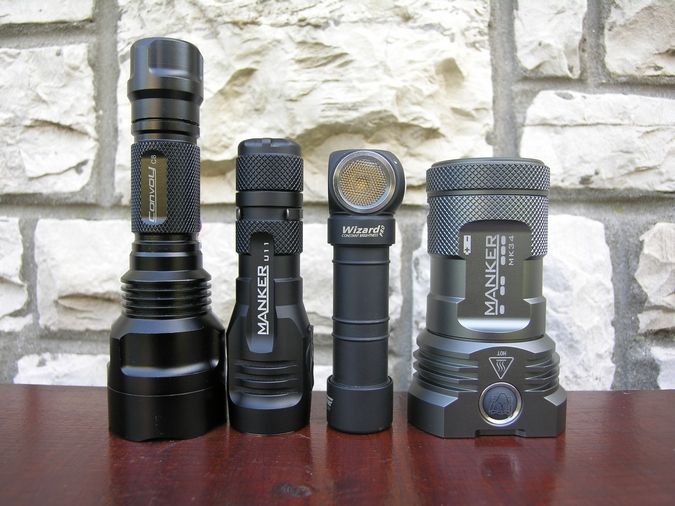
The head is reasonably bigger (55 mm).
Convoy C8, Manker U21, Manker MK34, Nitecore TM16GT.
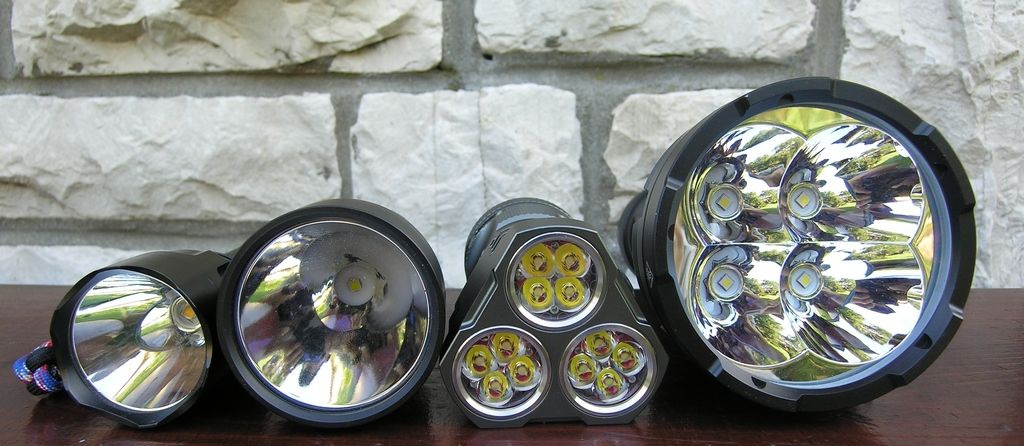
I’ve handled many lights during the last years. However, this light looks… strange. When I screw the head on the body, I have the feeling I am joining 2 parts from different lights… a Frankenlight!

The overall size is very small, as you could tell from the above pics.
I have medium sized hands (EU size), and the body of the light feels just fine in my hand.
I usually find lager batteries bodies not so comfortable keep in hand (especially for longer period of time), and heavier.
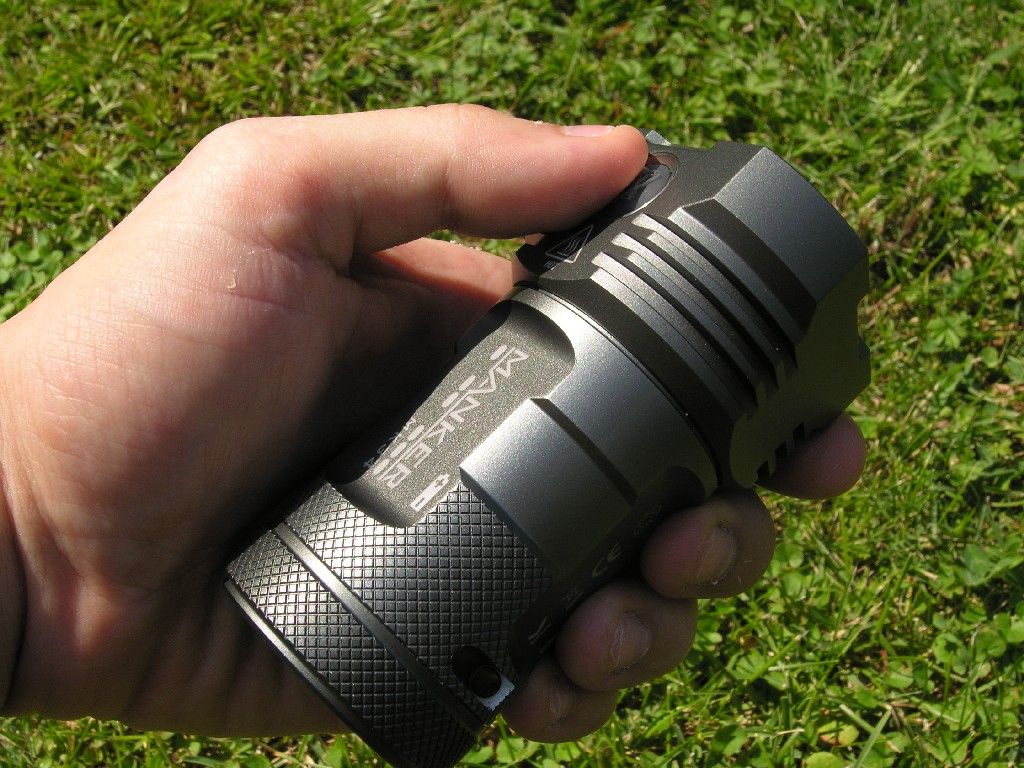
With the light in hand, the finger points directly at the switch on the head.
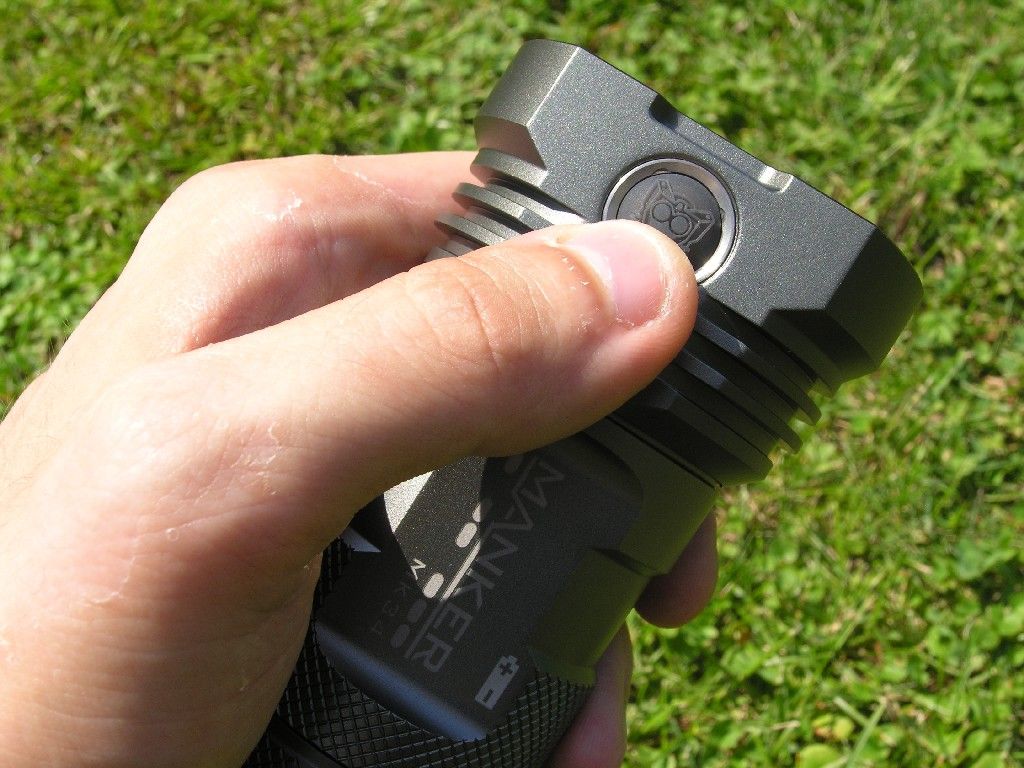
The switch protrudes slightly from the surface. It requires a bit more pressure to work than most of other lights. No problem for the fingers, and avoid accidental activation (although physical lockout is possible).
Here’s what’s under the optic:
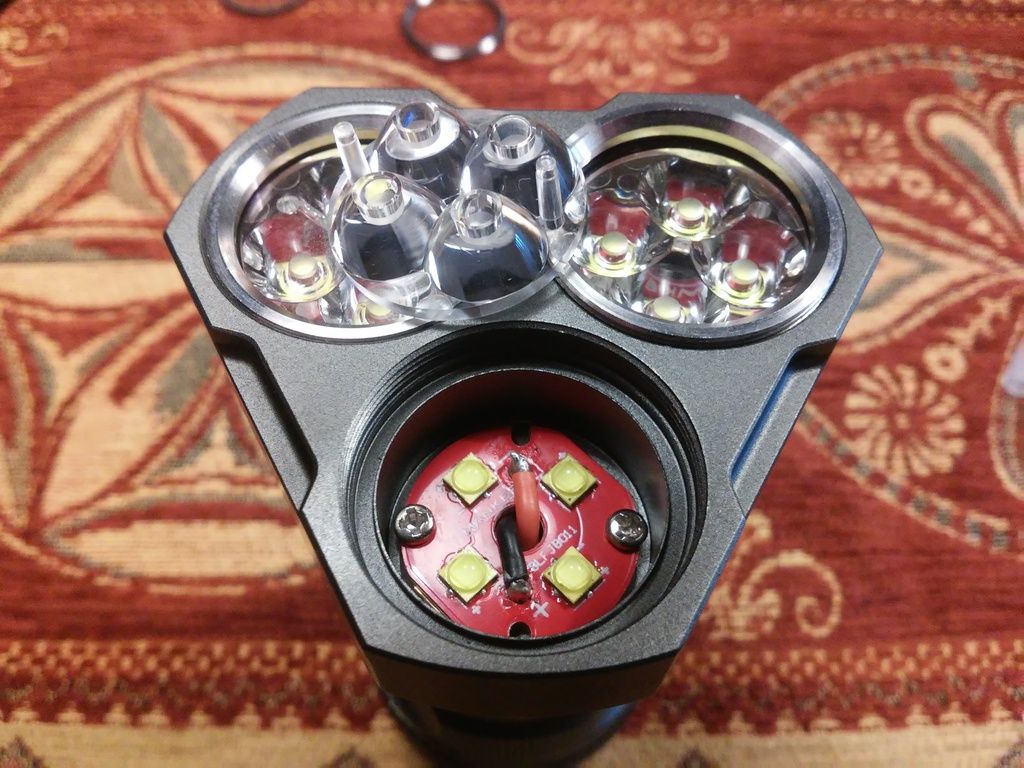
UI

1.When the flashlight is off, one click, access to moonlight mode (left part of the figure), one click to circle: Moonlight - Low - Medium 1 - Medium 2 - High. Long press for light off.*
2. When the flashlight is off, long press to access to the mode your last use as in left part of the figure (Memory function), one click for circle. Long press for off.
3. When the flashlight is off, double click access to Turbo, one click for circle. Long press for light off.
4. When the flashlight is on, double click to switch between the two groups (left and right part of the figure)
Basically, the UI is very similar to the one of the other Manker lights, but it has improved: you keep access to the lowest mode and the last used mode… but finally you can directly access to turbo mode.
When the battery is running low the LED under the switch will be purple (<50), and later on red(<20).
*if you are in high, and keep pressing the switch, the light will switch levels in this order: high, mid2, mid1, low, moonlight.
The output of the moonlight mode is 0.1 – 30 lumens because using the engineering mode (indicated in the graph) you can change it.
Beamshots in the real world (where the tripod screw comes handy).
The usual disclaimer: I am a terrible photographer.
To the my eye the pics with 4” of exposure are a bit overexposed, and the ones with 2” of exposure are underexposed. So try to imagine something in between the two images.
The purpose of my image is to catch the type of the beam and his more relevant aspects.
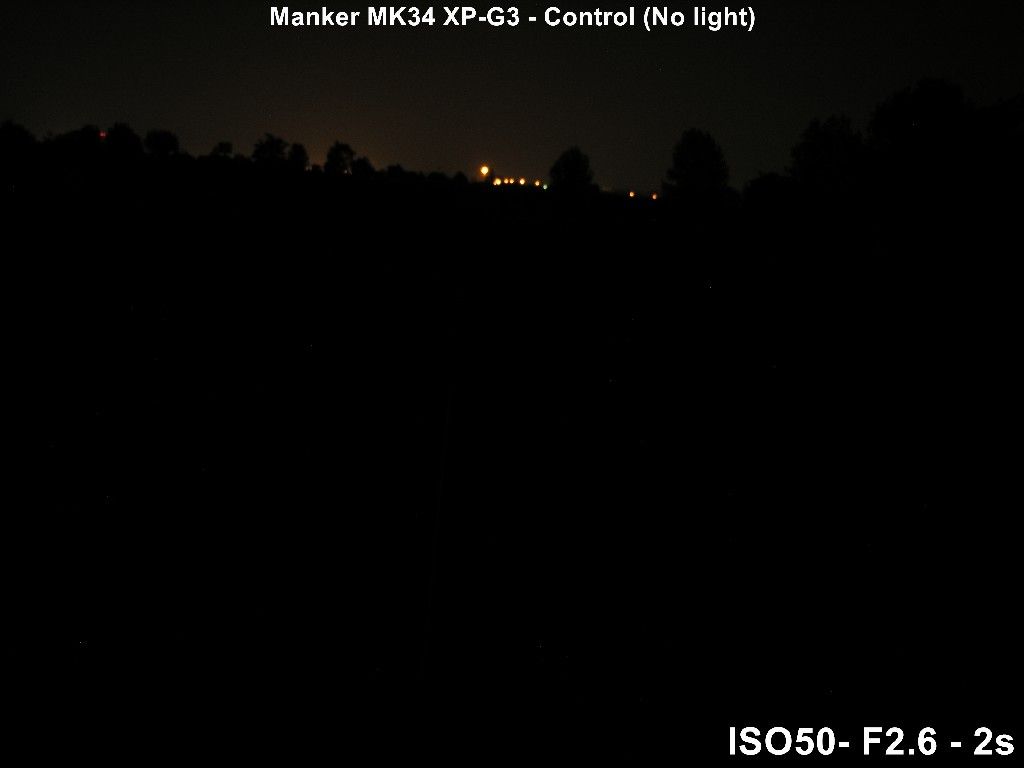
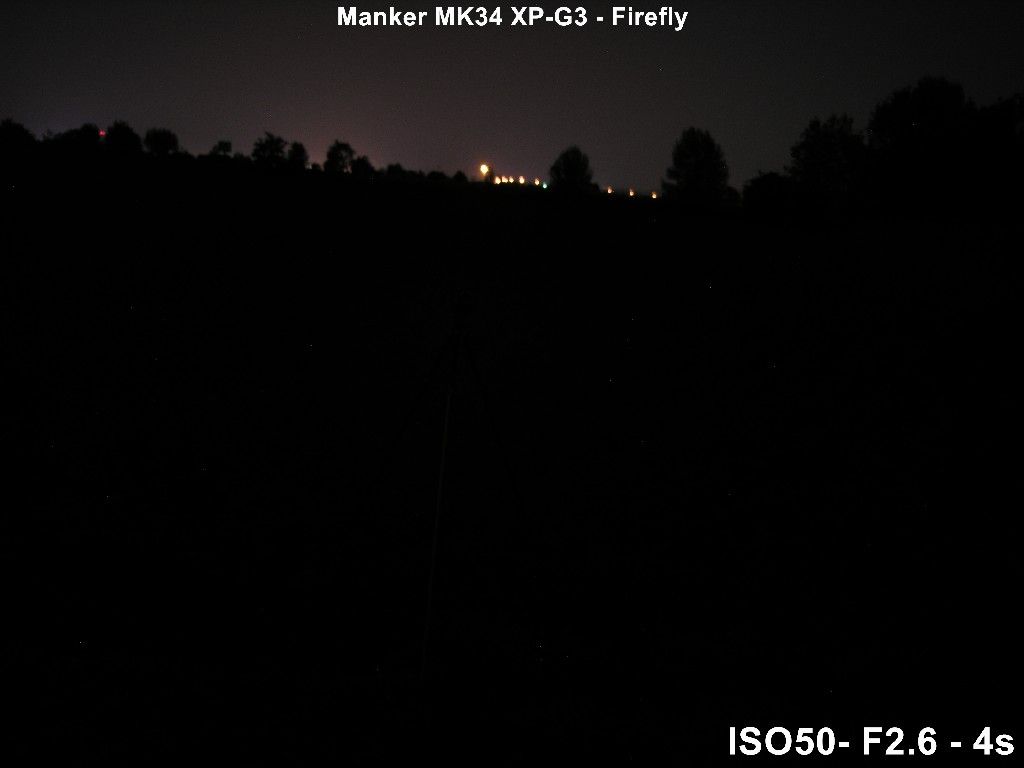
The log of the tree you can see around a bit on the right from the center of the pic is 100 meters from the position of the light, measured with google maps. I measured roughly the same distance with my laser telemeter (the max distance is 100 meters for this instrument, and I got 97 meters a few meters from the tree).
So I believe that this distance is accurate.
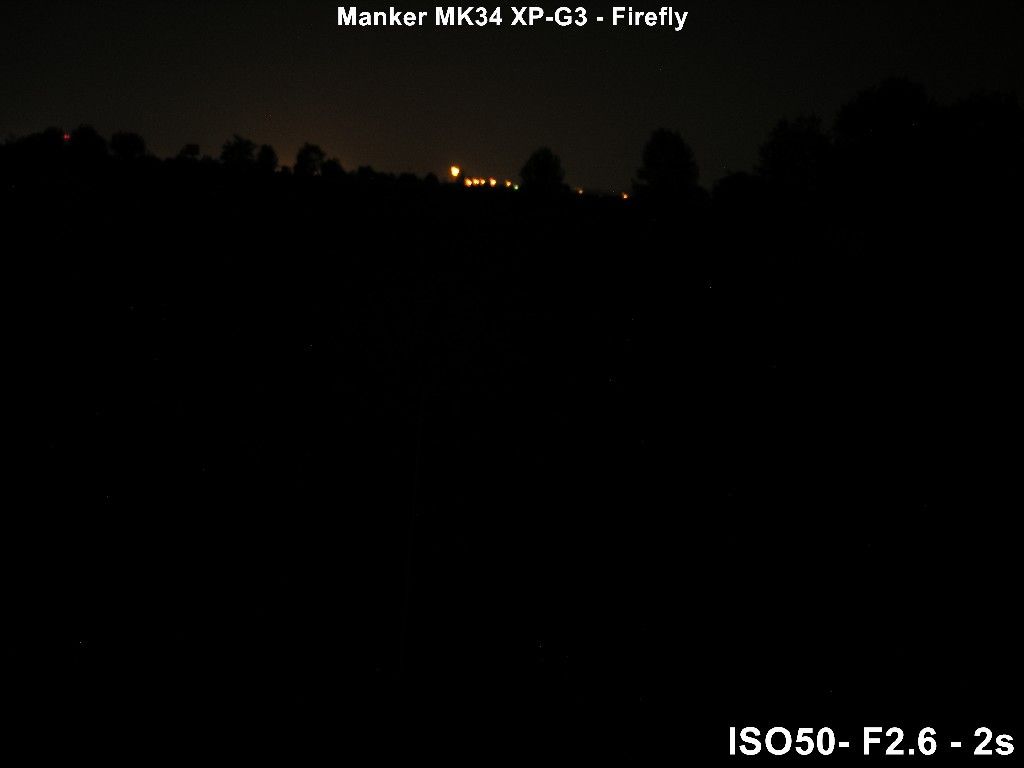
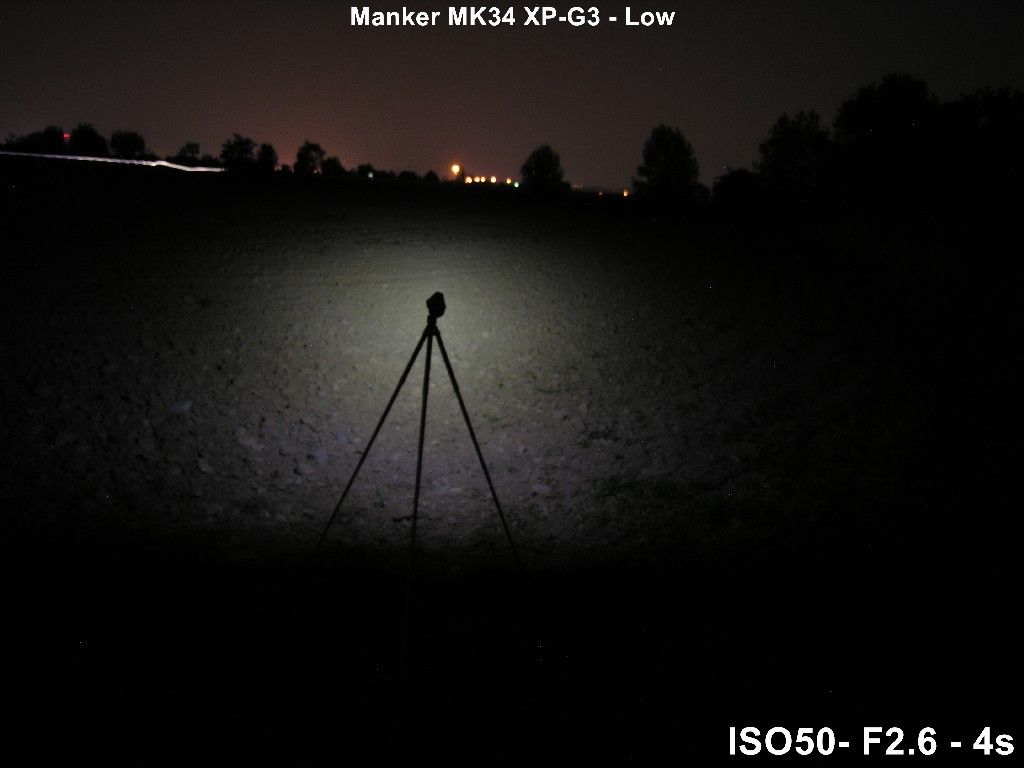
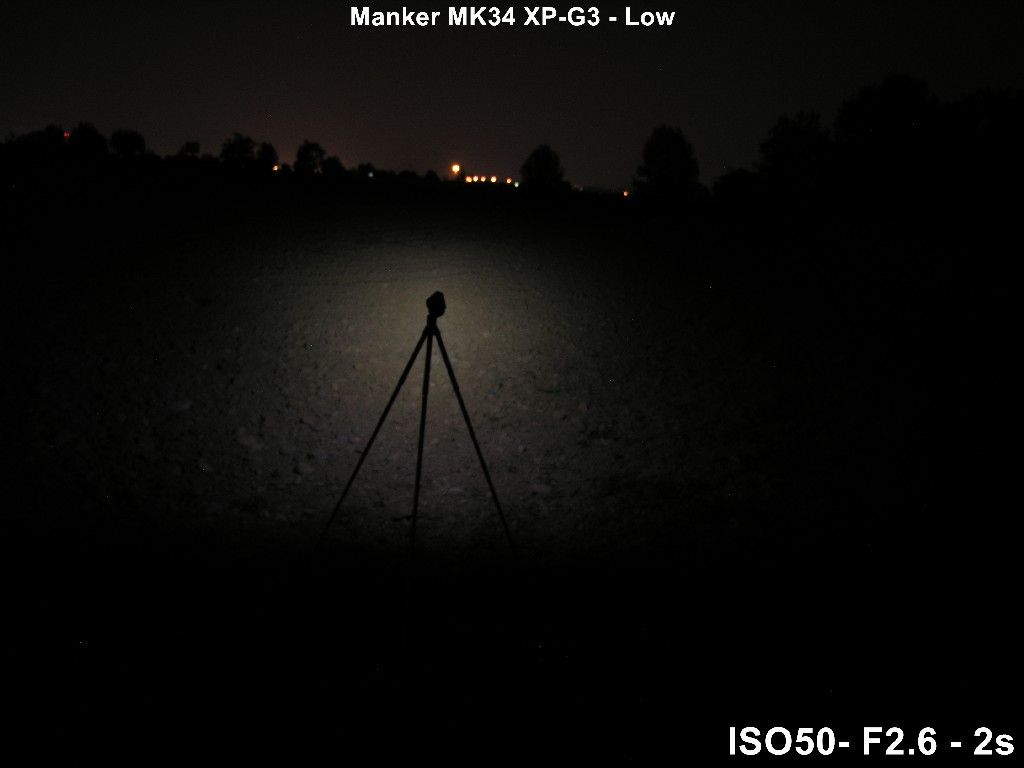
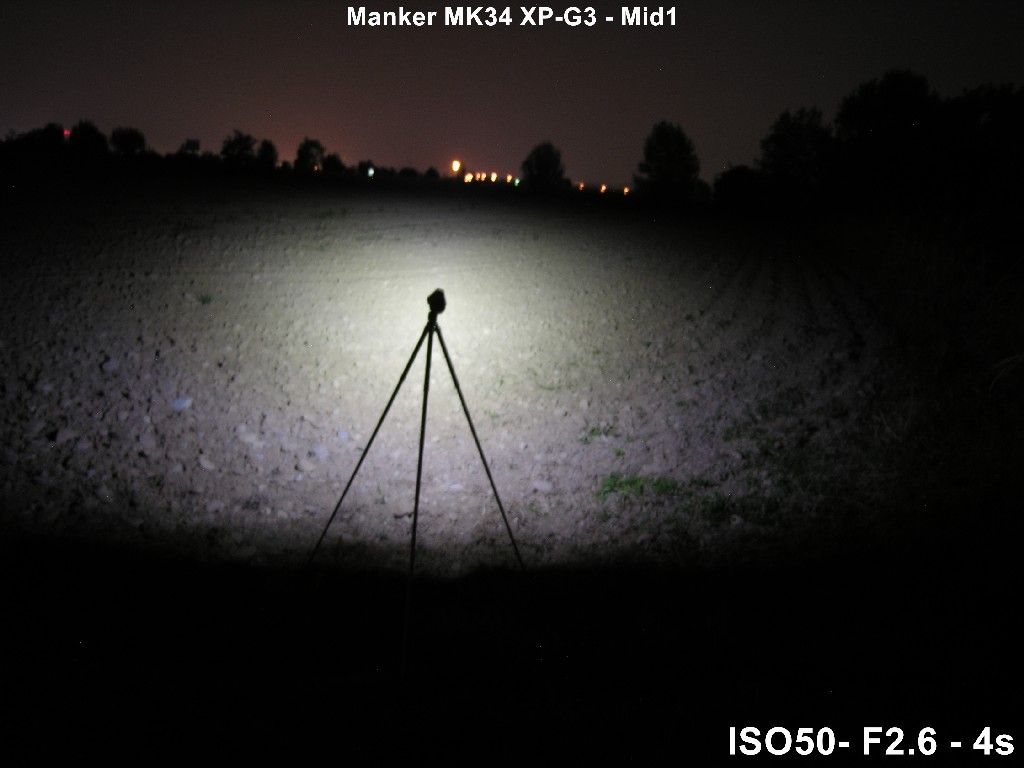
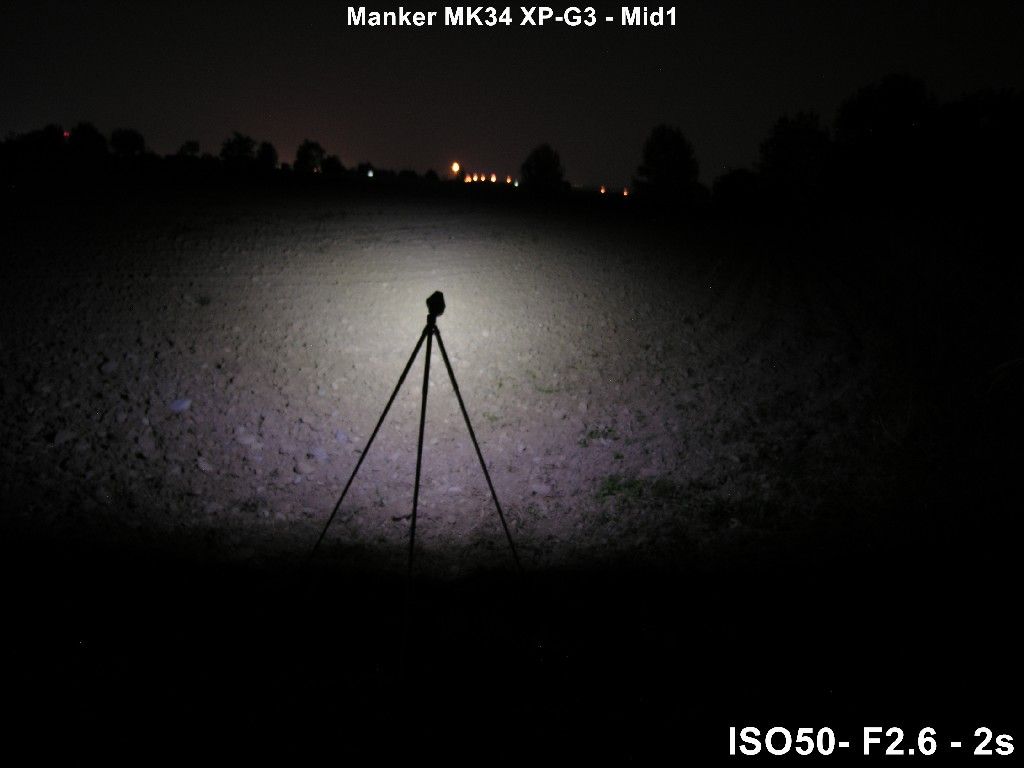
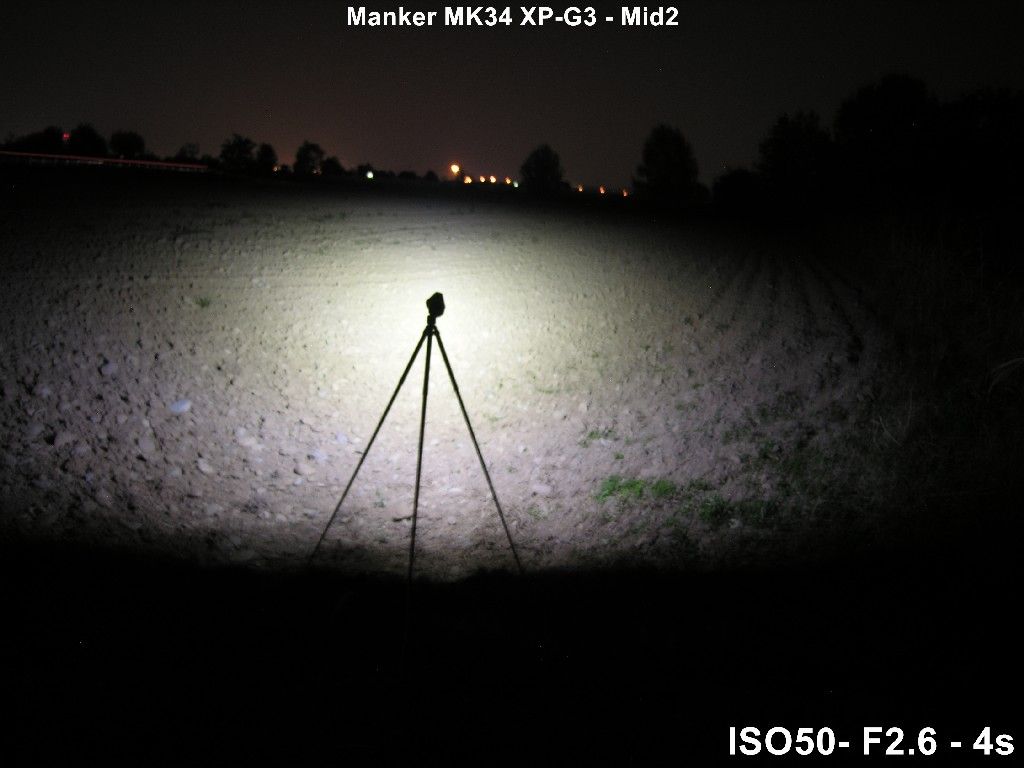
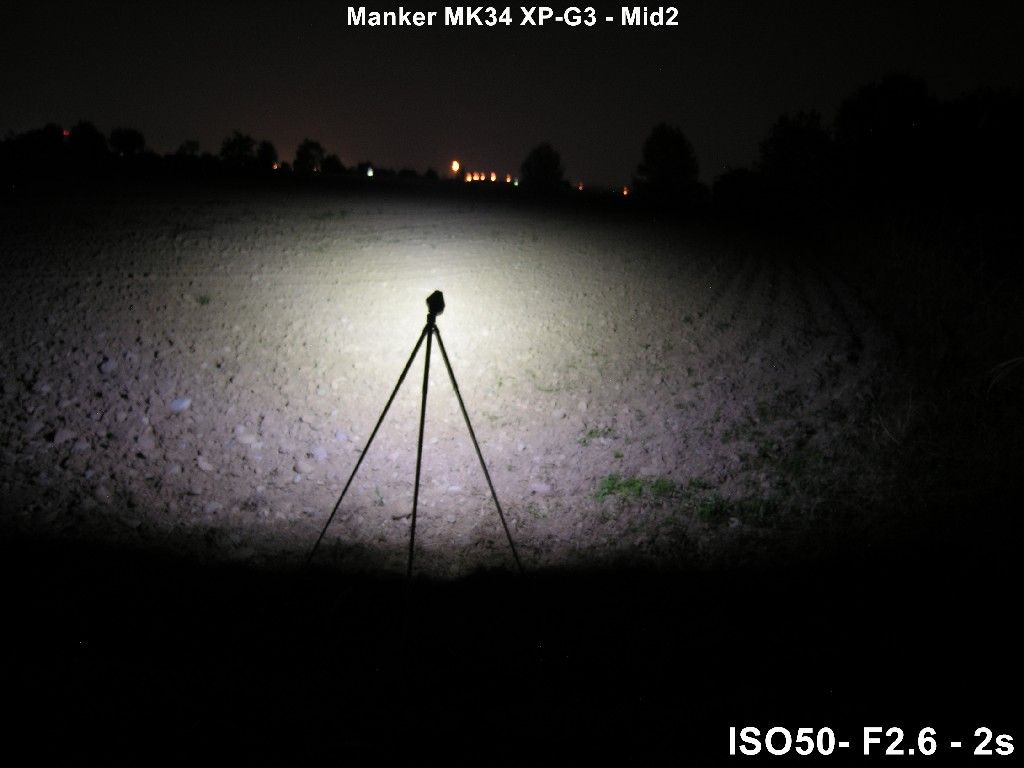
At high mode I could see the ground up to 75 meters, and up to 100 (97ish) at turbo mode.


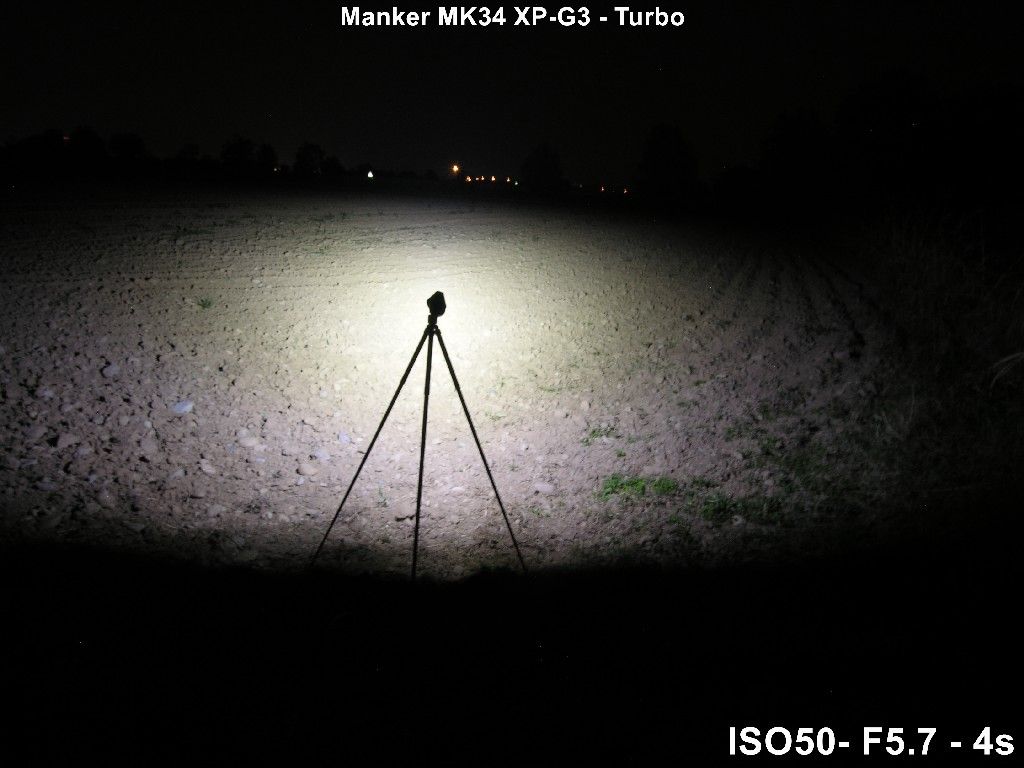
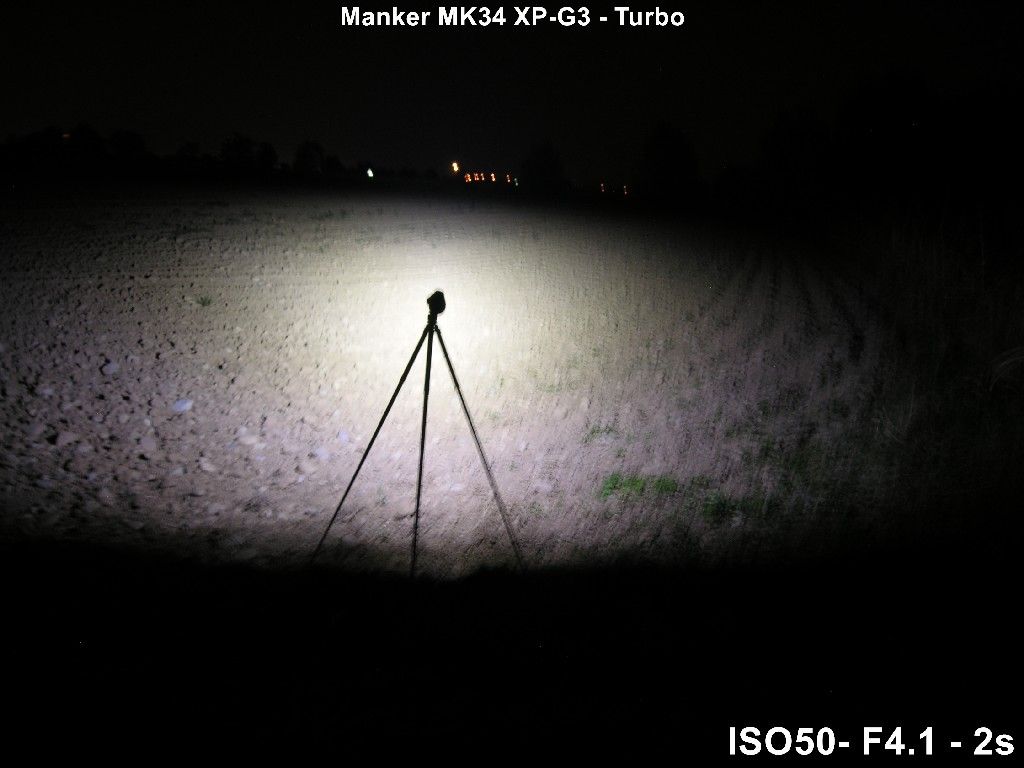
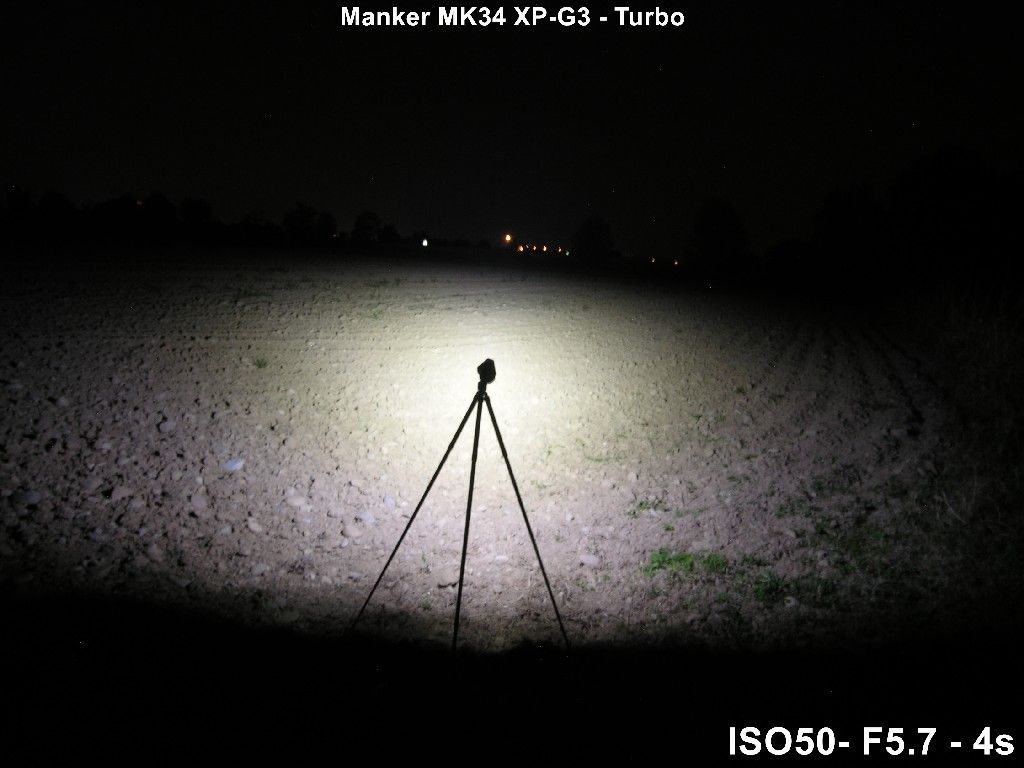
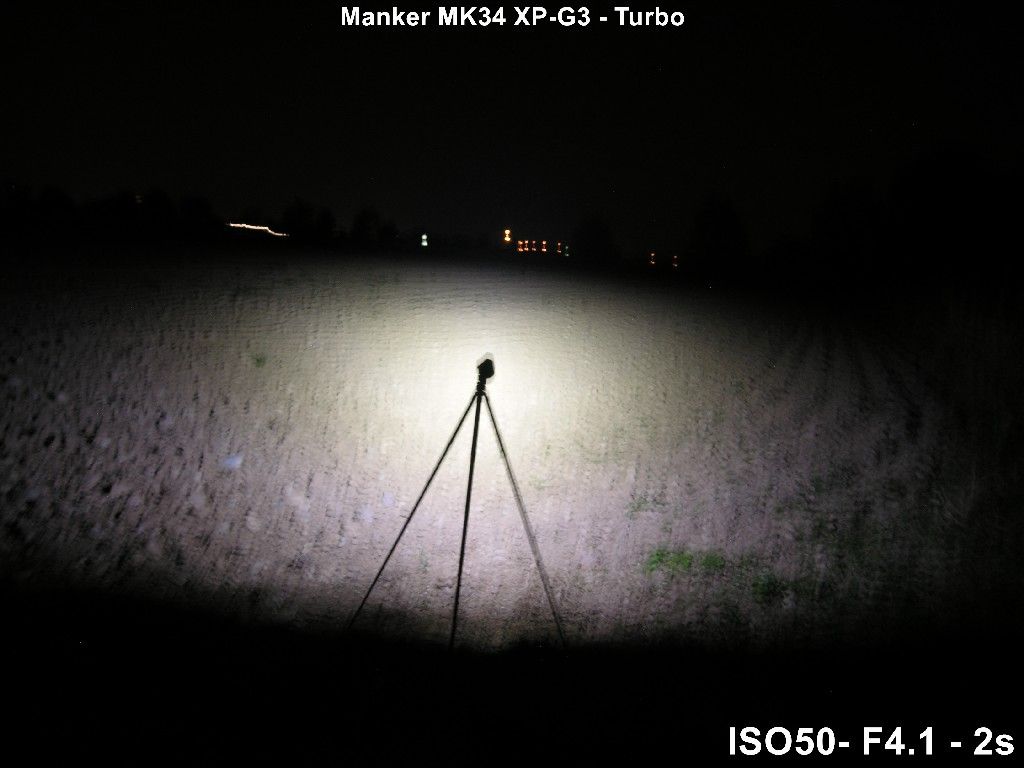
Sorry for the blurry pics. The danger of putting the tripods on a freshly ploughed field.
No surprises here. 12 XP-G3 in very small optics, will give a very wide and smooth beam.
Output and Runtime
Manker recommends using unprotected high drain 18650 batteries with the MK34.
For the testing I used 3 LG HG2 battery.
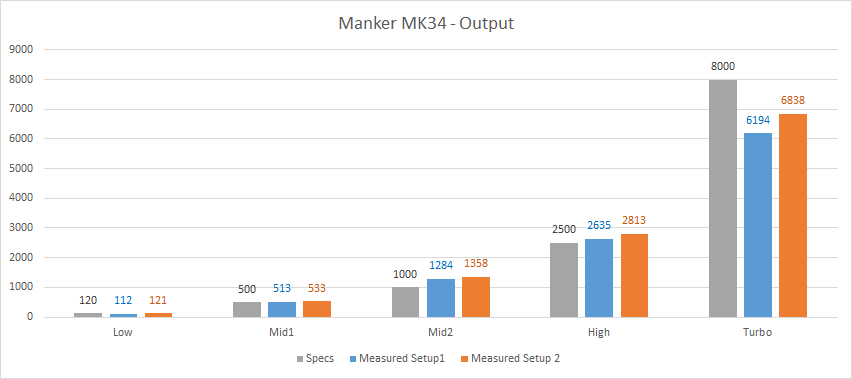
I found the output declared by Manker to be underestimated for low, mid1, mid2 and hi mode, but I couldn’t get the 8000 lumen they measured at the turbo mode.
I went back to my old setup with a bigger and more empty room (which I moved away because the setup 2 is in a smaller room which allows to read lower values from less potent lights), and I got improved readings for all levels.
In the next days I will try again changing the setup, even different batteries.
Meanwhile there is no meaning holding back this review.
I will update this review and the graphics if and when I will get different results, as I did in the past.
Sampling is every 2” for turbo and high mode, every 6” for mid2.
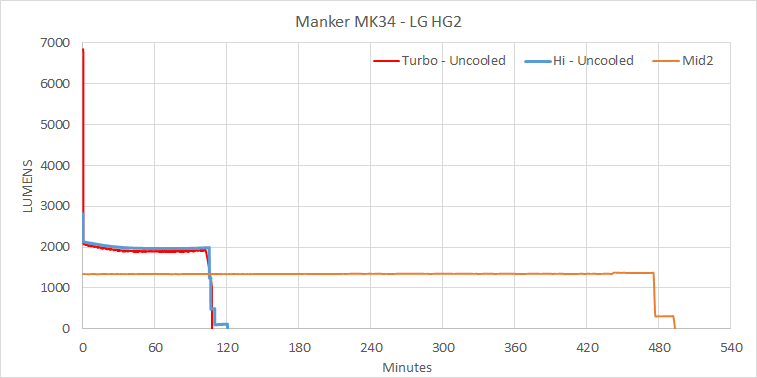
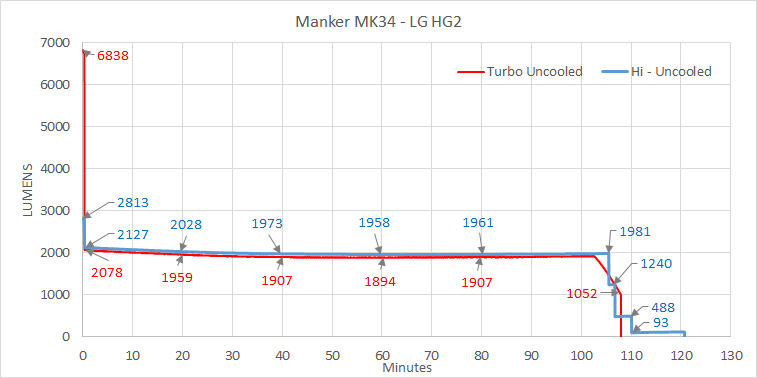

The 2 plots are practically a match.
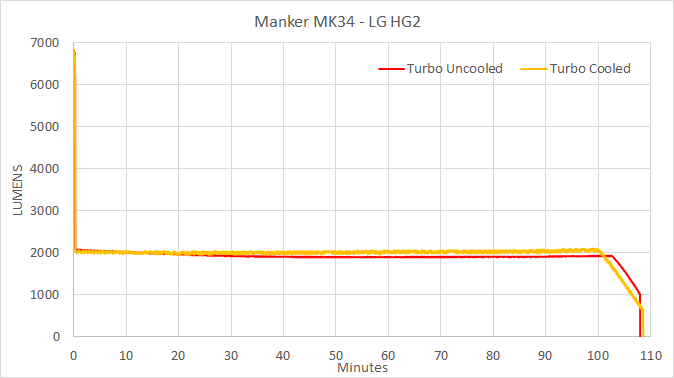
After the runtime test at High mode, I measured 3.06 resting volts for each battery, and 3.04 volt after Turbo and med2. Always above the minimum voltage recommended for li-ion.
When you have a thousand lumens coming from a small light, expect it to be hot.
When you have thousandS lumens coming from a small light, expect it to be very, very hot.
Also, after the test at Turbo mode the outer plastic ring at the head, that protects against polarity inversion, fell off. There were tiny signs of glue that could not survive the heat.
I won’t spend a second gluing it back on my sample, since on my cells the negative pole of the light is always recessed.
My thoughts.
The light is well built, and has a very distinguishable design.
I believe this is one of the light with higher output/size ratio of the multi emitter multi battery segment on the market at the moment.
Usually I don’t have trouble putting in a pocket of my winter jacket a bigger light, like a King, a Eagletac SX25L3 MT-G2, or a Kalrus G30. This light is even smaller (not only shorter, but the triangular cut head saves size and weight compared to a circular head).
The light is very well regulated, as I expected from Manker.
Even if I was not able to get close to their 8000 lumens measurement, you can’t tell this light has a low output.
It would be nice to have a 3000 lumens continuous output… but you can’t hold a flashlight once it melts your hands ![]()
The runtime is really good. This light will give you, after the stepdown, 2000 lumens for almost 2 hours at high mode, and a bit more than 1300 for 4 hours. Both with flat regulation.
I really like that this light works with batteries in parallel configuration. This configuration is safer and allows you to run the light with 1 or 2 18650 (the output may fade depending on the quality of the light, and the runtime will be much lower, but in emergency I can do so; for example I can take out one of the 18650 and use it in another light or device).
The UI is improved: finally a light from Manker where I can access low, last used and turbo mode. I hope they keep this UI for their next lights.
I like the 2 tint options, although I would like to have a warmer option than 5000K (but with good CRI). After all the testing, I plan to change the emitters on my sample with something around 3500K.
The only issue I have with this light is very picky on the size of the battery.
The first try I did with LG MJ1 with a 3 mm magnet on top (since they are flat top). I use this system in all lights that require button top (like the Nitecore TM16GT).
The MJ1 with the magnet was too long for the MK34, and I discover it when I pulled out of the light the battery, it had the positive pole pushed in and the magnet was no slightly protruding from the surface of the positive pole (and the light worked).
So I took 3 LG HG2 and put some solder on top of them, this way they are button top AND shorter than having a magnet on top.
After the testing they were fine (not crushed), althought they had some small marks on the negative pole, and the wrapping was getting damaged.
This is not a problem because changing the wrapping of an unprotected battery takes 30 seconds.
Well, I wanted a short light and I have to use short batteries.
My advice is to pick short batteries AND to not overtight the head on the body when the batteries are in place.
I’d like Manker to provide a holster for this light.
Apart from this small details, this is a really well put toghether light. From the construction to the light that produces, to how it produces it.
The price is very reasonable, considered the segment of the light.
I hope I can test the nichia version of the light and make some comparatives.
HEre is summarized the review. At 8:30 you see the light in action.
Thanks to: AntoLed for the camera and the luxmeter, Zampa for the tripod.
Thanks for reading.
